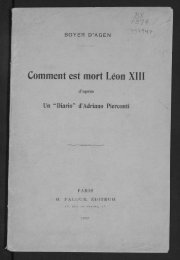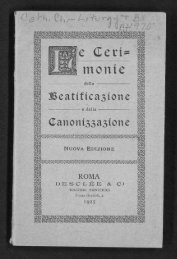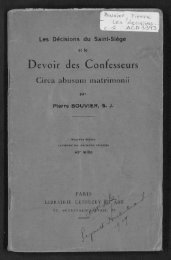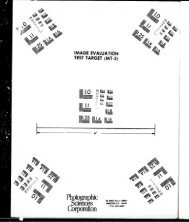Fabiola : or, The church of the catacombs - Digital Repository Services
Fabiola : or, The church of the catacombs - Digital Repository Services
Fabiola : or, The church of the catacombs - Digital Repository Services
You also want an ePaper? Increase the reach of your titles
YUMPU automatically turns print PDFs into web optimized ePapers that Google loves.
I<br />
FABIOLA;<br />
OR<br />
THE CHURCH OF THE CATACOMBS.<br />
PART FIRST PEACE.<br />
CHAPTER I.<br />
THE CHRISTIAN HOtTSE.<br />
IT is on an afternoon in September <strong>of</strong> <strong>the</strong> year 302, that we invite<br />
our reader t< > accompany us through <strong>the</strong> streets <strong>of</strong> Rome.<br />
<strong>The</strong> sun has declined, and is about two hours from his setting ;<br />
<strong>the</strong> day is cloudless, and its heat has cooled, so that multitudes<br />
are issuing from <strong>the</strong>ir houses, and making <strong>the</strong>ir way towards<br />
i-' gardens on one side, <strong>or</strong> Sallust's on <strong>the</strong> o<strong>the</strong>r, to enjoy<br />
<strong>the</strong>ir evening walk, and learn <strong>the</strong> news <strong>of</strong> <strong>the</strong> day.<br />
But <strong>the</strong> part <strong>of</strong> <strong>the</strong> city to which we wish to conduct our<br />
friendly reader is that known by <strong>the</strong> name <strong>of</strong> <strong>the</strong> Campus Martins.<br />
It comprised <strong>the</strong> flat alluvial plain between <strong>the</strong> seven<br />
hills <strong>of</strong> older Rome and <strong>the</strong> Tiber. Bef<strong>or</strong>e <strong>the</strong> close <strong>of</strong> <strong>the</strong><br />
republican period, this field, once left bare f<strong>or</strong> <strong>the</strong> athletic and<br />
warlike exercises <strong>of</strong> <strong>the</strong> people, had begun to be encroached<br />
upon by public buildings. Pompey had erected in it his<br />
<strong>the</strong>atre ; soon after, Agrippa raised <strong>the</strong> Pan<strong>the</strong>on and its ad-<br />
his <strong>The</strong>rmae* on <strong>the</strong> Quirinal, not far from Sallust's garden just<br />
alluded to.<br />
<strong>The</strong> particular spot in <strong>the</strong> Canfpns Martins to which we will<br />
direct our steps, is one whose situation is so definite, that we<br />
i-urately describe it to any one acquainted with <strong>the</strong> topography<br />
<strong>of</strong> ancient <strong>or</strong> modern Rome. In republican times <strong>the</strong>re<br />
wn.-, a large square space in <strong>the</strong> Campus Martius, surrounded<br />
by boarding, and divided into pens, in which <strong>the</strong> Comitia, <strong>or</strong><br />
meeting <strong>of</strong> <strong>the</strong> tribes <strong>of</strong> <strong>the</strong> people, were held, f<strong>or</strong> giving <strong>the</strong>ir<br />
votes. This was called <strong>the</strong> Septa, <strong>or</strong> Ovile, from its resemblance<br />
to a sheepfold. Augustus carried out a plan, described<br />
by Cicero in a letter to Atticus,t <strong>of</strong> transf<strong>or</strong>ming this homely<br />
contrivance into a magnificent and solid structure. <strong>The</strong> Septa<br />
Jiii in, as it was <strong>the</strong>ncef<strong>or</strong>th called, was a splendid p<strong>or</strong>tico <strong>of</strong><br />
1000 by 500 feet, supp<strong>or</strong>ted by columns and ad<strong>or</strong>ned w>h<br />
paintings. Its ruins are clearly traceable ; and it occupied <strong>the</strong><br />
space now covered by <strong>the</strong> D<strong>or</strong>ia and Verospi palaces (running<br />
thus along <strong>the</strong> present C<strong>or</strong>so), <strong>the</strong> Roman College, <strong>the</strong> Church<br />
<strong>of</strong> St. Ignatius, and <strong>the</strong> Orat<strong>or</strong>y <strong>of</strong> <strong>the</strong> Caravita.<br />
<strong>The</strong> house to which we invite our reader is exactly opposite,<br />
and on <strong>the</strong> east side <strong>of</strong> this edifice, including in its area, <strong>the</strong> present<br />
<strong>church</strong> <strong>of</strong> St. Marcellus, whence it extended back towards<br />
<strong>the</strong> foot <strong>of</strong> <strong>the</strong> Quirinal hill. It is thus found to cover, as noble<br />
Roman houses did, a considerable extent <strong>of</strong> ground. From <strong>the</strong><br />
Hitsido it presents but a blank and dead appearance. <strong>The</strong><br />
walls are plain, without architectural <strong>or</strong>nament, not high, and<br />
scarcely broken by windows. In <strong>the</strong> middle <strong>of</strong> one side <strong>of</strong> this<br />
angle is a do<strong>or</strong>, in anils, that is, merely relieved by u<br />
tympanum <strong>or</strong> triangular c<strong>or</strong>nice, resting on two half columns<br />
Using our privilege aa " artiste<br />
"<br />
<strong>of</strong><br />
fiction, <strong>of</strong> invisible<br />
ubiquity,<br />
tJ-.ib. iv. up. 16.<br />
we will enter in with our friend, <strong>or</strong> " shadow," as he would<br />
have been anciently called. Passing through <strong>the</strong> p<strong>or</strong>ch, on<br />
<strong>the</strong> pavement <strong>of</strong> which we read, with pleasure, in Mosaic, <strong>the</strong><br />
greeting SALVE, <strong>or</strong> WELCOME, we find ourselves in <strong>the</strong> atrium,<br />
<strong>or</strong> first court <strong>of</strong> <strong>the</strong> house, surrounded by a p<strong>or</strong>tico <strong>or</strong> colon-<br />
nade.*<br />
In <strong>the</strong> centre <strong>of</strong> <strong>the</strong> marble pavement a s<strong>of</strong>tly warbling jet<br />
<strong>of</strong> pure water, brought by <strong>the</strong> Claudian aqueduct from <strong>the</strong><br />
Tusculan hills, springs into <strong>the</strong> air, now higher, now lower,<br />
and falls into an elevated basin <strong>of</strong> red marble, over <strong>the</strong> sides <strong>of</strong><br />
which it flows in downy waves ; and bef<strong>or</strong>e reaching its lower<br />
and wider recipient, scatters a gentle shower on <strong>the</strong> rare and<br />
brilliant flowers placed in elegant vases aroun'd. Under <strong>the</strong><br />
p<strong>or</strong>tico we see furniture disposed, <strong>of</strong> a rich and sometimes rare<br />
character ; couches inlaid with iv<strong>or</strong>y, and even silver ; tables<br />
<strong>of</strong> <strong>or</strong>iental woods, bearing candelabra, lamps, and o<strong>the</strong>r household<br />
implements <strong>of</strong> bronze <strong>or</strong> silver ; delicately chased busts,<br />
vases, tripods, and objects <strong>of</strong> mere art. On <strong>the</strong> walls are paintings<br />
evidently <strong>of</strong> a f<strong>or</strong>mer period, still, however, retaining all<br />
<strong>the</strong>ir brightness <strong>of</strong> col<strong>or</strong> and freshness <strong>of</strong> execution. <strong>The</strong>se are<br />
joining baths. But gradually it became occupied by private<br />
dwellings while <strong>the</strong> ;<br />
Mils, in <strong>the</strong> early empire <strong>the</strong> aristocratic<br />
p<strong>or</strong>tion <strong>of</strong> <strong>the</strong> city, were seized upon f<strong>or</strong> greater edifices. Thus<br />
<strong>the</strong> Palatine, after Nero's fire, became almost too small f<strong>or</strong> <strong>the</strong><br />
imperial residence and its separated by<br />
adjoining Circus Maximus. <strong>The</strong> Esquiline<br />
was usurped by Titus's baths, built on <strong>the</strong> ruins <strong>of</strong> <strong>the</strong><br />
Golden House, <strong>the</strong> Aventine by Caracalla's and at <strong>the</strong> ;<br />
period<br />
<strong>of</strong> which we write, <strong>the</strong> Emper<strong>or</strong> Dioclesian was covering <strong>the</strong><br />
sufficient f<strong>or</strong> many l<strong>or</strong>dly dwellings, by <strong>the</strong> erection <strong>of</strong><br />
niches with statues, representing, indeed,<br />
dent.<br />
As outside <strong>the</strong> columns, <strong>the</strong> coving ro<strong>of</strong> leaves a large square<br />
opening in <strong>the</strong> centre, called <strong>the</strong> impluvium, <strong>the</strong>re is drawn<br />
across it a curtain, <strong>or</strong> veil <strong>of</strong> dark canvas, which keeps out <strong>the</strong><br />
sun and rain. An artificial twilight <strong>the</strong>ref<strong>or</strong>e alone enables us<br />
like <strong>the</strong><br />
pictures, mythological and hist<strong>or</strong>ical subjects ; but we cannot<br />
help observing, that nothing meets <strong>the</strong> eye which could <strong>of</strong>fend<br />
<strong>the</strong> most delicate mind. Here and <strong>the</strong>re an empty niche, <strong>or</strong><br />
a covered painting, proves that this is not <strong>the</strong> result <strong>of</strong> acci-<br />
to see all that we have described ; but it gives greater effect to<br />
what is beyond. Through an arch, opposite to <strong>the</strong> one<br />
whereby we have entered, we catch a glimpse <strong>of</strong> on inner and<br />
still richer court, paved with variegated marbles, and ad<strong>or</strong>ned<br />
with bright gilding. <strong>The</strong> veil <strong>of</strong> <strong>the</strong> opening above, which,<br />
however, here is closed with thick glass <strong>or</strong> talc (lapis specularis),<br />
has been partly withdrawn, and admits a bright but<br />
s<strong>of</strong>tened ray from <strong>the</strong> evening sun on to <strong>the</strong> place, where we<br />
see, f<strong>or</strong> <strong>the</strong> first time, that we are in no enchanted hall, but in<br />
an inhabited house.<br />
Beside a table, just outside <strong>the</strong> columns <strong>of</strong> Phrygian marble,<br />
sits a matron not beyond <strong>the</strong> middle <strong>of</strong> life, whose features,<br />
noble yet mild, show traces <strong>of</strong> having passed through s<strong>or</strong>row<br />
at some earlier period. But a powerful influence has subdued<br />
<strong>the</strong> recollection <strong>of</strong> it, <strong>or</strong> blended it with a sweeter thought ; and<br />
<strong>the</strong> two always come toge<strong>the</strong>r, and have long dwelt united in<br />
her heart. <strong>The</strong> simplicity <strong>of</strong> her appearance strangely con-<br />
trasts with <strong>the</strong> richness <strong>of</strong> all around her ; her hair, streaked<br />
with silver, is left uncovered, and unconcealed by any artifice ;<br />
her robes are <strong>of</strong> <strong>the</strong> plainest col<strong>or</strong> and texture, without embroidery,<br />
except <strong>the</strong> purple ribbon sewed on, and called <strong>the</strong><br />
Kci/nirntuin, which denotes <strong>the</strong> state <strong>of</strong> widowhood ; and not<br />
a jewel <strong>or</strong> precious <strong>or</strong>nament, <strong>of</strong> which <strong>the</strong> Roman ladies<br />
were so lavish, is to be seen updn her person.<br />
<strong>The</strong> only thing<br />
approaching to this is a slight gold c<strong>or</strong>d <strong>or</strong> chain round her<br />
neck, from which apparently hangs some object, carefully<br />
concealed within <strong>the</strong> upper hem <strong>of</strong> her dress.<br />
At <strong>the</strong> time that we discover her she is busily engaged<br />
* <strong>The</strong> Pompeian Court in <strong>the</strong> Crystal Palace will have familiarized many<br />
readers with tbe foime <strong>of</strong> an ancient house.

















